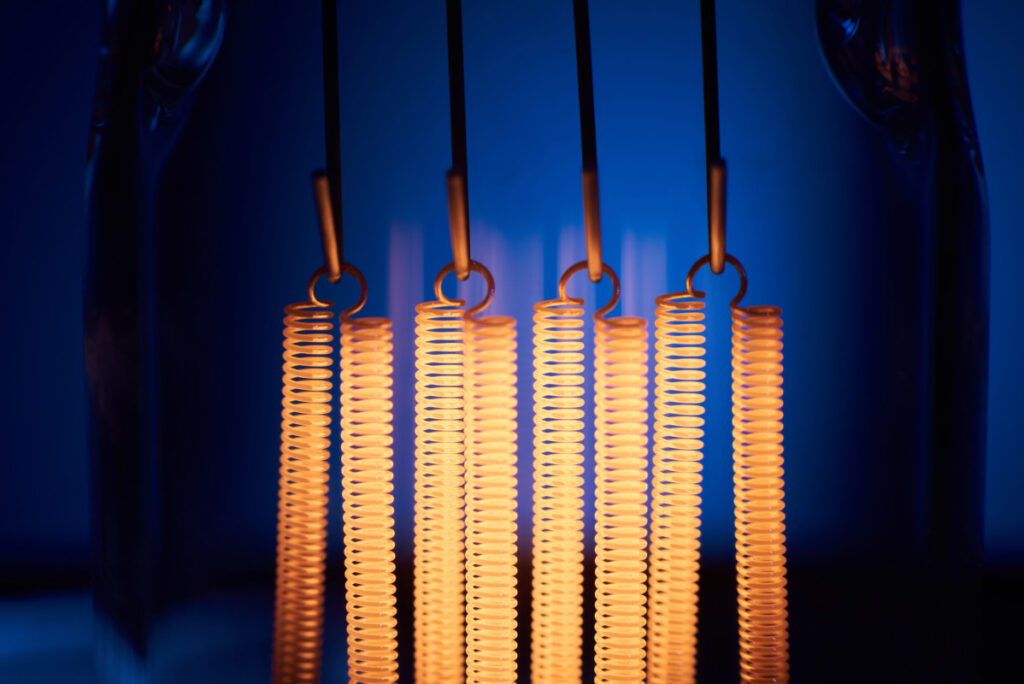A thermocouple is a temperature sensor consisting of two different metals joined at one end to form a hot junction, while the open end of the wire acts as the cold junction. The hot junction is in contact with the process. When the measurement point (the hot junction) is heated, an EMF (Electromotive Force) is generated at the cold junction due to the difference in electron density of the two different metals and the temperature difference between the cold and hot ends.
Since there are many types of thermocouples, there are some important things to consider to choose the right thermocouple type according to the temperature measurement range and required attributes. Here are various types and designs of thermocouples:
| Type | Useful/General Application Range | Notes |
| B | 1370-1700°C (2500-3100°F) | Type B is recommended for use up to 1700°C (3100°F). This thermocouple is easily contaminated. Reducing atmospheres are very damaging to calibration. Precious metal thermocouples should always be protected with gas-tight ceramic tubes, secondary alumina tubes, and silicon carbide or outer metal tubes as appropriate. |
| C* | 1650-2315°C (3000-4200°F) | This refractory metal thermocouple can be used up to 2315°C (4200°F). Due to its lack of oxidation resistance, its use is limited to vacuum, hydrogen, or inert atmospheres. |
| E** | 95-900°C (200-1650°F) | Type E thermocouples are suitable for use up to 900°C (1650°F) in vacuum, inert, mildly oxidizing, or reducing atmospheres. At cryogenic temperatures, the thermocouple does not undergo corrosion. This thermocouple has the highest EMF output per degree of all commonly used thermocouples. |
| J | 95-760°C (200-1400°F) | Type J can be used, open or unexposed, where there is a lack of free oxygen. For cleanliness and longer life, protective tubes are recommended. Since JP wire (iron) oxidizes rapidly above 540°C (1000°F), larger gauge wire is recommended to compensate. The maximum recommended operating temperature is 760°C (1400°F). |
| K** | 95-1260°C (200-2300°F) | Due to its reliability and accuracy, Type K is widely used up to 1260°C (2300°F). It is good practice to protect this type of thermocouple with suitable metal or ceramic protective tubes, especially in reducing atmospheres. In oxidizing atmospheres, such as electric furnaces, protective tubing is not always required if other conditions are met; however, it is recommended for cleanliness and general mechanical protection. Type K generally lasts longer than Type J because JP wire (iron) oxidizes quickly, especially at higher temperatures. |
| N | 650-1260°C (1200-2300°F) | This nickel-based thermocouple alloy is used primarily at high temperatures up to 1260°C (2300°F). While not a direct replacement for Type K, Type N provides better oxidation resistance at high temperatures and longer life in sulfur-containing applications. |
| R | 870-1450°C (1600-2640°F) | The maximum recommended operating temperature for Type S or R is 1450°C (2640°F); these thermocouples are easily contaminated. Reducing atmospheres are very damaging to calibration. Precious metal thermocouples should always be protected with gas-tight ceramic tubes, secondary alumina tubes, and silicon carbide or outer metal tubes as appropriate. |
| S | 980-1450°C (1800-2640°F) | The maximum recommended operating temperature for Type S or R is 1450°C (2640°F); these thermocouples are easily contaminated. Reducing atmospheres are very damaging to calibration. Precious metal thermocouples should always be protected with gas-tight ceramic tubes, secondary alumina tubes, and silicon carbide or outer metal tubes as appropriate. |
| T** | -200-350°C (-330-660°F) | This thermocouple can be used in either oxidizing or reducing atmospheres, although protective tubes are recommended for longer life. Due to its stability at lower temperatures, it is an excellent thermocouple for various low and cryogenic temperature applications. The recommended operating range is -200°C to 350°C (-330°F to 660°F), but it can be used down to -269°C (-452°F) (helium boiling point). |
*ANSI symbol
**Also suitable for cryogenic applications from -200 to 0°C (-328 to 32°F)
Tempsens offers different models of standard temperature sensors and complete thermocouple accessories. We provide thermocouples that are highly resistant to vibration, consumption, and more.
Here are some advantages and disadvantages of different types of thermocouples, such as S, R, B, N, K, E, J, and T. Among them, S, R, and B are precious metal thermocouples, and N, K, E, J, and T are base metal thermocouples.
- Type S Thermocouple: This is a platinum-iridium 10-platinum thermocouple with the highest accuracy, best stability, wide temperature range, and long life. It is suitable for oxidation and inert atmospheres. Its disadvantages include low thermoelectric potential, low sensitivity, reduced mechanical strength at high temperatures, high sensitivity to pollution, and the high cost of precious metal materials, making it a significant one-time investment. The long-term maximum operating temperature is 1300°C, and the short-term maximum operating temperature is 1600°C.
- Type R Thermocouple: It has the highest accuracy, best stability, wide temperature range, and long life in the thermocouple series. It has good physical and chemical properties, good thermoelectric potential stability, and high oxidation resistance at high temperatures, making it suitable for oxidation and inert atmospheres. Because the performance of Type R thermocouples is comparable to Type S, it is difficult to promote in China. Apart from temperature measurement applications in imported equipment, it is rarely used domestically. The disadvantages are low thermoelectric potential, low sensitivity, reduced mechanical strength at high temperatures, high sensitivity to pollution, and the high cost of precious metal materials, making it a significant one-time investment.
- Type B Thermocouple: This thermocouple series has the highest accuracy, best stability, wide temperature range, long life, and high-temperature limits. It is suitable for use in oxidation and inert atmospheres, as well as short-term use in a vacuum, but not in reducing atmospheres or in atmospheres with metal or non-metal vapors. The clear advantage is that no compensation cables are needed for compensation because the thermoelectric potential is less than 3 μV in the range of 0 to 50°C.
- Type K Thermocouple: It has good linearity, large thermoelectric force, high sensitivity, good stability and uniformity, strong anti-oxidation performance, and a low price, making it widely used by users. Type K thermocouples cannot be used directly at high temperatures in sulfur, reducing, or reducing atmospheres, in alternating oxidizing atmospheres, and in a vacuum, and are not recommended for use in weakly oxidizing atmospheres. It is currently the most widely used base metal thermocouple, accounting for the majority of other thermocouples. The usage temperature is -200 to 1300°C.
- Type N Thermocouple: A standardized new thermocouple, Type N has good linearity, large thermoelectric force, high sensitivity, good stability and uniformity, strong oxidation resistance, low price, and no nearby reservation. Type N thermocouples cannot be used directly at high temperatures in sulfur, reducing or reducing atmospheres, in alternating oxidizing atmospheres, and in a vacuum, and are not recommended for use in weakly oxidizing atmospheres.
- Type E Thermocouple: Also known as nickel-chromium-constantan thermocouple, it is a low-cost base metal thermocouple with a large thermoelectric force and the highest sensitivity among all thermocouples. It should be used in high humidity environments as it is not sensitive to corrosion in such conditions. Type E thermocouples also have good stability, better oxidation resistance than copper-constantan and iron-constantan thermocouples, low cost, and so on, making them suitable for oxidation and inert atmospheres and widely used by users. They cannot be used directly at high temperatures in sulfur, and thermoelectric potential is poor in reducing atmospheres. The usage temperature is -200 to 900°C.
- Type J Thermocouple: Also known as iron-constantan thermocouple, it is a low-cost base metal thermocouple. The usage temperature range is 0 to 750°C. It has good linearity, large thermoelectric force, high sensitivity, good stability and uniformity, and a low price, making it widely used by users. Type J thermocouples can be used in vacuum, oxidation, reduction, and inert atmospheres, but the positive iron oxidizes quickly at high temperatures, limiting the usage temperature. It cannot be used directly in vulcanizing atmospheres at high temperatures without protection.
- Type T Thermocouple: Also known as copper-constantan thermocouple, it is an optimal thermocouple for low-temperature measurement
Consult your needs immediately for free via WhatsApp with our team at (+62)852-1066-5767. Make sure you get the right heating element solution for your industrial application needs. Don’t forget to visit our website at smartheat.co.id and Smart Heat social media at @Smartheat.


